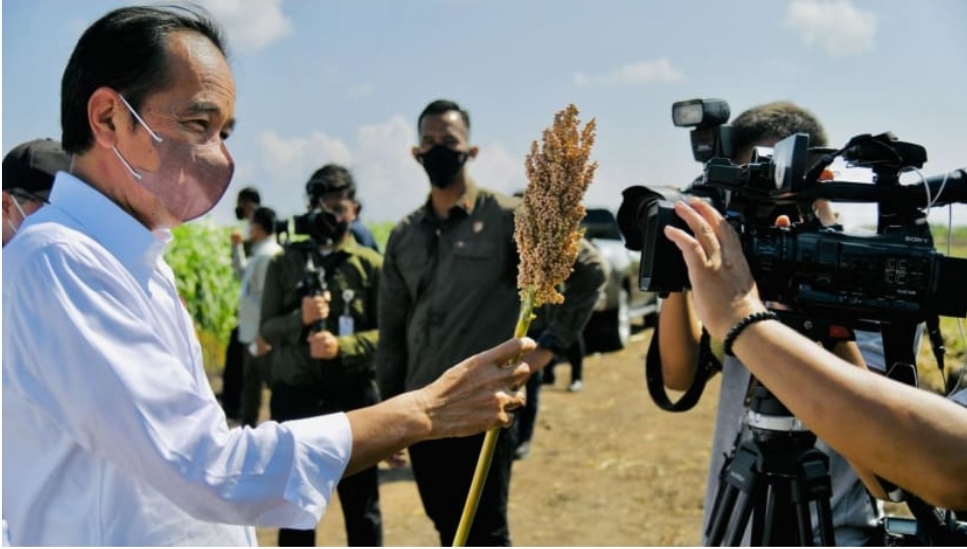Indonesia turns to sorghum as alternative staple food

Indonesian President Joko Widodo visits a sorghum field in East Nusa Tenggara on June 2, 2022.
By Kiki Siregar
Indonesian Maria Loretha used to study law at a university in East Java. But it is not her expertise in law which makes her a household name in East Flores regency in the province of East Nusa Tenggara.
It is her persistence in educating people about sorghum, a cereal plant, which earns the 54-year-old activist, the nickname ‘Mama Sorghum’.
For about 10 years, Mdm Loretha has been going from one place to another to train communities about sorghum and how to cultivate it.
“I was given the nickname Mama Sorghum in 2013 because at that time I was probably the only person nationwide who went to various places to introduce it to communities,” said Mdm Loretha.
She had never known about the plant until a neighbour gave it to her in 2007.
“I personally was intrigued in preserving it because of the taste,” she said, describing the flavour as a bit nutty and sweet.
“When a neighbour gave it to me I asked her whether there were any seeds for me to plant,” said Mdm Loretha, adding however, there were not enough sorghum seeds to plant in her land of 3ha.

Maria Loretha has been dubbed ‘Mama Sorghum’ due to her consistency in introducing sorghum to communities. (Photo: Facebook/ Maria Loretha)
Therefore, she felt challenged to find the seeds in East Flores.
“So I started looking for the seeds from village to village. Something pushed me to keep going.
“And I found out that sorghum was still being cultivated by some farmers who lived in remote areas far away from roads and with bad electricity.”
It was not an easy task to convince others to preserve the crop, she said, as they were used to eating rice and did not see the necessity to plant and consume it.
Over time, people understand the nutritional benefits of consuming sorghum as well as the economic benefits of planting it.
Today, about 1,000 people, mostly female farmers, are involved in sorghum cultivation in about eight regencies in East Nusa Tenggara.
President Joko Widodo visited the province last June and was impressed with how locals cultivate the cereal.
He is even convinced that sorghum should be a national staple food to reduce people’s reliance on rice or wheat.
It would also reduce Indonesia’s dependence on wheat exports which have been affected by increased uncertainty due to climate change and the Ukraine war.
“We want to have lots of (food) alternatives, lots of choices that we can cultivate in our country (for the purpose of) food diversification and food ingredient alternatives.
“(So) we don’t only depend on rice. Instead, we can have corn, sago and sorghum, which is our ancient crop,” said Mr Widodo, who is also popularly known as Jokowi, when visiting a sorghum field recently.
In August, Jokowi instructed his ministers and relevant officials to draw up a roadmap for Indonesia’s sorghum production.
Analysts CNA spoke to believed that sorghum could be a solution to the country’s depleting rice stocks which forces the government to import.
This month, the government decided to import 200,000 tons of rice to replenish the state logistics agency (Bulog) rice stocks that have been depleted.
Sorghum is a cereal plant which is usually round and comes in a variety of colours such as white, yellow, red, brown, black and purple.
It is resilient to climate change as it can grow widely on fertile and infertile land with limited water, said Prof. Muhammad Azrai, a cereal plant expert at the Ministry of Agriculture.
“Replanting sorghum several times can even make the soil more fertile,” he added.
Mr Laksana Tri Handoko, head of the National Research and Innovation Agency (BRIN) agreed, adding that this is in stark contrast to wheat which is generally unsuitable in the tropics.
Presidential chief of staff Moeldoko, who accompanied Jokowi when he visited the sorghum field in June, predicts that the El Nino climate pattern will dominate next year which would result in drier weather conditions.
“If it’s dry season, there will be fires everywhere, especially forests, and there’s bound to be crop failures such as the paddy rice and corn.
“But sorghum is relatively resilient to weather conditions as it doesn’t need continuous water to grow like rice.”

Sorghum comes in a variety of colours. (Photo: Facebook/ Maria Loretha)
Processing sorghum requires a different technology from rice paddy because the character of the seed is very different but generally, it does not require high technology, said the head of BRIN, Mr Handoko.
From a health perspective, sorghum contains high nutritional values such as protein, carbohydrates and calcium, said Prof Azrai who is also a lecturer in agriculture at Makassar’s Hasanuddin University.
“So it is safe to consume to prevent and reduce diabetes as the number of people who have diabetes tends to increase,” he said.
Therefore, he supports the government’s move to make sorghum an alternative staple food in Indonesia.
According to Prof Azrai, the increased production of sorghum should also help Indonesia’s economy.
“If it is managed properly, it can increase the national economy because sorghum can revive the economy of rural communities.
“The prospect of sorghum-based bioenergy will also be very promising when we are able to manage and market it professionally so that nothing is wasted, especially for bioethanol, energy briquettes or biopellets as well as plywood raw materials,” he explained.
Besides, sorghum flour can also be processed into various processed foods, be it in traditional or modern processing forms.
It can even be a solution to the country’s depleting rice stocks and could help the country from having to import rice.
As more people consume sorghum, less dependent they will be on rice as their staple food, said experts.
Sorghum makes one feel full faster and for a much longer period of time compared to rice, said Prof Azrai.
:
OBSTACLES TO OVERCOME
Mr Handoko of BRIN notes that there are several obstacles to overcome in getting wider public adoption of the cereal as an alternative source of staple food.
“The current obstacle is that there is not yet an adequate market for sorghum consumption. This requires market education and appropriate product development,” he told CNA.
“However, sorghum flour has the potential to be used as a partial substitute for wheat, perhaps up to 15 per cent of the mixture without reducing the texture and taste of its derivative products,” he explained.
Mr Handoko said that as part of the 2024 sorghum production roadmap, BRIN is currently developing new varieties of sorghum that are suitable for specific locations in the country.
BRIN is also trying to cultivate varieties of sorghum which would be developed into flour as well as a substitute for sugarcane.
According to Mr Moeldoko, who was once the country’s military chief, it is quite possible that historically Indonesians were used to eating sorghum.
“Sorghum is carved on Borobudur temple’s relief sculptures. So that means Indonesians have been eating sorghum for a long time.
“But the question is, why is it not progressing? Because there is no ecosystem for it to develop further,” he pointed out.
Mr Moeldoko said there is no off-taker for people to rigorously plant sorghum.
“The problem is there are no off-takers. So the industry is not well-developed.
“There are some who cultivate it but it is still a small group. Hence, research about sorghum is limited unlike corn or paddy rice,” he told CNA.
For now, the agriculture ministry aims to plant 15,000 ha of sorghum this year in East Nusa Tenggara province which will be increased to about 200,000 ha by 2024, he said outlining the roadmap.
He said that the target is to plant 15,000 ha in East Nusa Tenggara province because the stunting rate due to poor nutrition is still quite high.
“The hope is that if the communities grow sorghum and there are good off-takers, it can reduce stunting and extreme poverty rates,” said Mr Moeldoko.

Indonesian President Joko Widodo poses with a sorghum plant in East Nusa Tenggara on June 2, 2022.
PUBLIC EDUCATION ON SORGHUM
The government has so far been trying to educate more people about sorghum by holding festivals in Central Java and Jakarta where they hand out sorghum breakfast boxes.
It aims to hold more such events in the upcoming years, Mr Moeldoko revealed.
The government is not the only one working to introduce people to sorghum.
Jakarta-based non-governmental organisation (NGO) Kehati also aspires to preserve sorghum as a food source.
“Indonesia has a rich variety of food sources. If the food source is lost, then the culture is also lost,” said Mdm Puji Sumedi, the NGO’s agriculture programme manager.
To get wider public acceptance of sorghum is one of the reasons why NGOs such as Kehati recognised the work of people like Mdm Loretha, who have shown commitment to preserving local wisdom. They gave her the Kehati Award several years ago.
The successful implementation of the government’s 2024 roadmap on sorghum cultivation, could see more individuals contributing as ‘Mama Sorghum’ in Indonesia.
For Mdm Loretha herself, she is optimistic that sorghum will be widely cultivated in her province.
“I hope East Nusa Tenggara province will become a role model where sorghum has successfully been planted, developed and consumed.
“So it will be just like rice,” she said.




